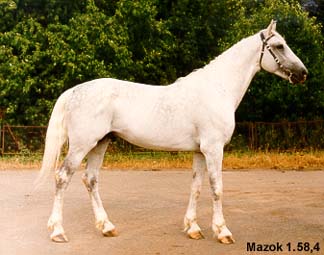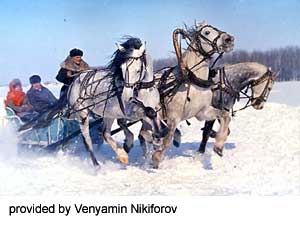

Orlov Trotter


Introduction: If you have any comments or suggestions, please click here.
Names: Orlov, Orlov Trotter. Names from other languages often have various spellings when people try to translate them, especially ones from languages like Russian that use a different alphabet. Orlov is frequently spelled using an F or two; the V (pronounced somewhat like an F) is probably the more accurate. As usual, I will use the shorter form. Takes its name from the man who first bred it, Count Alexis Orlov.
Origin: USSR, principal stud at Kranovoi. Also numerous small studs. This breed was the brain-child of Count Alexis Orlov, and was produced toward the end of the 18th century. The first stallion, an Arab, was crossed with a Dutch mare, and subsequent crossings were made with English Thoroughbred, Danish and Mecklenburg breeds, as well as additional Arab and Dutch.
Breeding: Bred
in large numbers, particularly at the Moscow State stud. They were
considered the fastest of all Trotters until the American Standardbred appeared on the
scene. Now a very recent Orlov Standardbred
cross, known as the Metis Trotter,
promises to be the fastest yet. The Orlov-Rostopschiner is an excellent
saddle horse.
(This was apparently inputted before I began to cite the dates
for my sources, so I don't really know when "now" was. It could
probably be dated to the 1970's or 80's. I have never heard of the Orlov-Rostopschiner,
but since I plan to eventually have every breed that has ever existed on this
site, I'm sure I will have something about it eventually!)
The Orlov was founded by the Russian Count Orlov-Chesmenski
in 1775 by crossing Oriental stallions with Danish and Dutch mares. Count
Orlov mated the Arab
silver-grey sire, Smetanka, with a Danish Frederiksborg
mare. The product, the stallion Polkan, was mated with a Dutch mare
and so begot Bars I, the progenitor of the Orlov breed. Thanks to
this combination, the skeleton of the Arab
was filled out with the bulk of the Danish mare and given the trotting ability
of the Dutch mare, while retaining the fiery temperament and energy of the
desert horse. Orlov trotters are used for breeding purposes only after
undergoing the toughest tests on the turf. After the Revolution, Standard-bred
blood was introduced frequetly in Russian breeding, so that today virtually no
pure-blooded Orlov trotter exists.
Description: According to one source, there are two types of Orlov--a heavy type, which is generally black, and another, more slender variety, which is usually grey and of Arab type. I was not aware that there were two types and that the lighter one was the one used for racing; will have to do more research into this.
Action: Fairly high, especially knee action. Rather short walking step; high, long striding trotting action with strong thrust from behind.
Body: Very fine neck-line. Rather straight shoulders, ample depth in the girth. Broad chest. Relatively long back. Powerfully developed loins; sloping round quarters. Tail set on low.
Color: Often gray, also black or bay. Very often grey with conspicuous dappling.
Hair: Some feather.
Head: Expressive and generally very refined with Arab traces.
Hooves: Sound, medium-sized.
Legs: Long, muscular forearms and cannons. Broad, hard cannon bones. Clearly marked tendons and joints. Rather long pasterns.
Size: 15.2-17 hands.
Temperament:
Features: Strong and quite heavy. Racehorse for trotting in sulky or sleigh. Very good harness characteristics, which also make the Orlov an elegant carriage horse.
Uses: Once used by cavalry. Trotting is also a favored sport in Russia, and the Orlov Trotter is world famous.
Accomplishments:
Curiosities:
Profiles:
Conclusion: